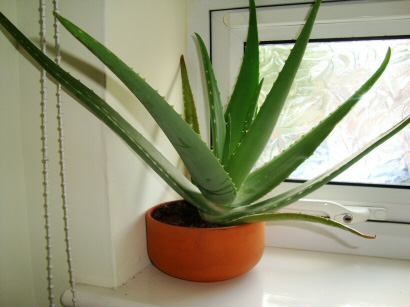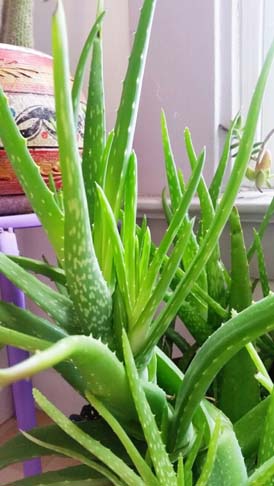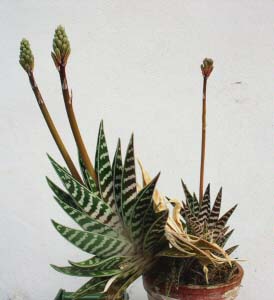





The Aloe plant is one of the more commonly known houseplants because of the Aloe Vera gel you find inside its leaves.  If you go into any chemist or department store, chances are you will find a product for sale which contains Aloe Vera gel and has a picture of the plant on the packaging.
If you go into any chemist or department store, chances are you will find a product for sale which contains Aloe Vera gel and has a picture of the plant on the packaging.
Aloe Vera Gel is sold to treat a lot of different aliments, from burns to helping support the health of the digestive system and because of the gels popularity it's not surprising that the plant itself has become easily recognisable.
We don't recommend only buying an Aloe Vera plant for its purported medicinal uses, because this indoor plant is actually fantastically easy to care for and a mature well cared for Aloe Vera can look incredibly striking and beautiful. Obviously the gel aspect may have have some advantages, so by all means keep the plant at hand in the event you get a small burn.
When it comes to other possible medical uses, we do get asked a lot if "the Aloe Vera plant is edible?" This is because it's reported to help with stomach complaints.  We really don't want to encourage you to cut bits off to eat, unless you truly know what you are doing. Some parts of the Aloe Vera plant are toxic and others can create laxative effects! If you're a serious Aloe Vera Gel believer it's best if you stick to the official products that have been created specifically for purpose. So again please no D.I.Y. experiments with the leaves unless you know what you're doing.
We really don't want to encourage you to cut bits off to eat, unless you truly know what you are doing. Some parts of the Aloe Vera plant are toxic and others can create laxative effects! If you're a serious Aloe Vera Gel believer it's best if you stick to the official products that have been created specifically for purpose. So again please no D.I.Y. experiments with the leaves unless you know what you're doing.
There are several different types of Aloe Vera plants you can buy and even more types of Aloe available. The majority make good houseplants, and grow very fast when compared to other succulents. In general unless you are searching in specialist shops the plant will simply be labeled as "A. vera". Different types can be sought although they all have similar care requirements as detailed below.
Light
Sitting your Aloe Vera plant in any South facing window is a great choice because it will get lots of sunlight. Like most succulents, it's literally designed for such places and as a result you will get lots of good quality and even growth.
However Aloe's will also be quite happy in a north facing aspect, growth will be slower and you will have to rotate the plant pot every month or so to ensure an even look. In general the Aloe Vera plant is adaptable when it comes to light and it's difficult to go wrong.
Watering
During Spring and Summer water thoroughly every time the soil has dried out. Where you decide to put the plant will dictate how long it takes for the soil to dry out and therefore how long you need to wait between watering's. Anything from a week up to three would be normal. Aloe's can use a lot of water in hot weather so don't let the watering can be a stranger.
In Autumn (Fall) and Winter, water much less frequently. Some people don't water their plants at all during Winter and if it's in a very cool spot this is probably a very good idea in order to prevent root / stem rot.
Humidity
Humidity is really not important for almost all succulents and this includes the Aloe Vera plant.
Feeding
Too much fertiliser on Aloe Vera's can produce very soft and bendy leaves which is normally undesirable in the rigid structural striking varieties. It's a good idea therefore to feed only once in Spring and once again in Summer with either a cactus or an all purpose feed. Only feed established plants.
Temperature
Like it's light requirements, an Aloe Vera will take very high temperatures in its stride so don't worry about overheating. It will expect a cooler temperature in Winter though, but not less than 5°C / 41°F.
Repotting
In a short space of time, Aloe Vera plants usually produce a lot of offsets or suckers which will gradually fill the pot. Repot when the pot becomes very congested. You can either keep all the plants together in a bigger pot if you prefer a "busy" appearance, or separate some of the offsets for propagation or to give away as gifts.
Propagation
When it comes to Aloe Vera plant propagation it's good news. It's very easy! Offsets or suckers from Aloe's are very straight forward to get going, as they do it mostly by themselves with little assistance from us. When you repot, gently separate the offsets from the parent ensuring each one has at least a few roots of its own. Use a free draining compost mix and water well, wait a few weeks before you water again and never heavily until the offset has properly established.
Speed of Growth
Your Aloe Vera plant growth will be moderately fast in good conditions. Very little growth should be expected if conditions are poor and of course over the Winter months.
Height / Spread
They normally only reach 45cm / 18in in height. But spread (over many years) can be immense due to the offsets which fan out around the plant.
Flowers
 The Aloe's do sometimes flowers indoors. Some types will flower annually and others less. The plant needs to be established and have reached maturity (4 - 6 years old). Good light conditions are also needed. They can flower at any time of the year and the flowering stem comes shooting out very quickly.
The Aloe's do sometimes flowers indoors. Some types will flower annually and others less. The plant needs to be established and have reached maturity (4 - 6 years old). Good light conditions are also needed. They can flower at any time of the year and the flowering stem comes shooting out very quickly.
Anything else?
These plants get heavy. Really heavy. You will save yourself a lot of trouble if you pick a pot which is wider than it is tall, i.e. a typical cactus style bowl that is wide and shallow. This will drastically help prevent the plant from tipping over when it starts to become unbalanced. Failing that, be sure that the container is heavy otherwise it will tip over at some point.
Copyright © www.100flowers.win Botanic Garden All Rights Reserved